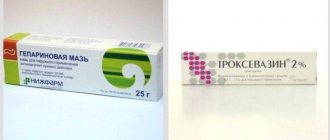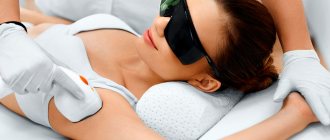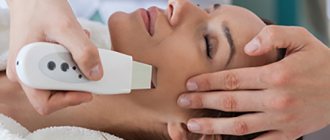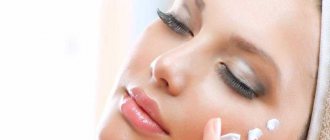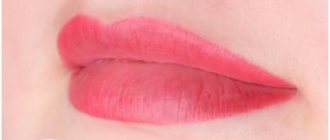One of the most common questions that a cosmetologist hears is: “After cleansing the face, how many days does the redness go away, when does the swelling go away?” Even the most qualified specialist will not be able to answer these questions unequivocally. There are a number of reasons that can aggravate the unpleasant consequences of the procedure.
Firstly, these are the characteristics of the cosmetologist’s patient’s dermis. If you are prone to acne, then the formation of pimples and inflammatory elements cannot be avoided. If the epidermis is hypersensitive, then redness may linger for more than three days.
The second reason for side effects of the procedure may be the unprofessionalism of the cosmetologist. Too much pressure during the cleansing process can cause the formation of wounds and hematomas. Insufficiently thorough cleaning of hands, skin, and tools can provoke infection and the formation of inflammation.
Possible consequences after facial cleansing and their causes
Cosmetologists warn their patients that after the procedure they may encounter some undesirable consequences. At its core, cleansing refers to a series of aggressive, even traumatic procedures. During the first 24 hours after it, the woman is likely to observe a reaction in the form of redness and slight swelling. This is considered a normal variant and does not require specific therapy.
Unpleasant consequences include the following:
- The formation of inflammatory elements or pimples. If sterility is maintained, this should not happen. The appearance of acne may indicate that the procedure caused the formation of a wound that became infected.
- Redness of the skin. Persistent redness that occurs after cleansing the face, which does not go away for more than 3 days, should alert you. Mechanical impact on the epidermis provokes a rush of blood and redness, which usually goes away after a few days.
- Formation of hematomas. This side effect indicates excess pressure when exposed to the problem area of the dermis.
- Edema. Swelling immediately after mechanical impact is considered normal. However, if after cleansing your face swelling appears and does not go away after three days, this is a reason to seek help from a specialist.
- Wounds and scars can occur if you have sensitive skin or unprofessional cleaning.
- Allergies occur when there is a hypersensitivity reaction to drugs used in cleaning.
Consequences
Facial cleansing has a number of consequences that go away quite quickly if you properly care for your skin:
- Redness.
- Pimples.
- Inflamed formations.
- Peeling.
- Swelling.
If the procedure is carried out incorrectly, small scars and other irregularities may appear, infection may enter the body, and general health may deteriorate.
How to remove redness?
A reminder on how to avoid redness:
- Carry out deep cleansing of the skin of the face exclusively in beauty salons and centers, as there are the most suitable conditions for such a procedure.
- Choose a qualified and experienced cosmetologist whom you can safely entrust your face to.
- Make sure that after the procedure the cosmetologist makes a mask for your face, since it is this that soothes the dermis and narrows enlarged pores.
How to wipe off redness?
Redness usually goes away within 2 days after the procedure. However, what if this does not happen? Remedies to eliminate redness:
- Facial gel with aloe vera extract.
- Chamomile decoction (can be used both in liquid and frozen form).
- Lactic acid (can be replaced with curdled milk, which has recently curdled).
- Green tea.
You can also use anti-inflammatory compresses and masks based on medicinal plants, which will help quickly eliminate unwanted redness.
What to do if acne appears?
Almost everyone, after cleansing their face, experiences the appearance of acne, which most often appears due to deep cleansing of the pores. You can quickly eliminate them in the following ways:
- Wash your face with a herbal decoction (chamomile, calendula or sage) to eliminate the inflammatory process, soothe the skin and destroy dangerous microorganisms.
- You can wipe off unwanted pimples with salicylic acid, which can be purchased at any pharmacy.
- Make clay masks to normalize sebum secretion.
- Do not squeeze out the formation under any circumstances, otherwise you can introduce an infection into the dermis or leave scars on your face.
If the situation does not improve, then you should immediately contact your cosmetologist, who will find out the cause of the rash and find an effective way to eliminate it.
Care masks
After cleansing your face, many cosmetologists recommend making soothing masks at home to quickly restore the skin.
Recommendations
- You should not use all mask recipes in a row; it is recommended to use only those prepared on the basis of medicinal, in particular antiseptic, drugs.
- Ask your cosmetologist which mask is best to perform at home after cleansing your face.
- Before applying the mask, perform an allergic reaction test on a small area of the skin on your hands.
- If the consequences after cleansing are minor, use fruit or vegetable based masks.
- You can perform such restorative face masks only once every 3 days.
Recipes
- Mix a little blue clay, potato-based starch and talcum powder in equal proportions. At the same time, grind aspirin and chloramphenicol into powder (half a tablet each), add alum with the tip of a knife. Pour the dry mixture with a previously prepared decoction based on the string and stir thoroughly, after which the mask is ready.
- Combine white clay and talc (thirty grams each), chloramphenicol powder (fifteen grams) into one mass, then add 3% peroxide.
- Combine melted honey (thirty milliliters) with pre-chopped oatmeal (fifteen grams), after which the mass can be applied to the skin of the face.
- Add chopped parsley (thirty grams) to 33% fat cream or sour cream (thirty grams). Apply the finished product to the surface of your face.
- Grate raw potatoes (fifteen grams) and add regular high-fat yoghurt to it until a puree-like consistency appears, after which the mask is ready for application.
- In yogurt, dilute yeast (ten grams) to a consistency reminiscent of sour cream, then add freshly squeezed strawberry juice (ten milliliters).
- Dilute Dimexide (five grams) in clean water (fifty milliliters) and wipe your face with this emulsion. After 30 minutes, apply Solcoseryl ointment to the surface of the face.
Such masks will allow you to quickly soothe your facial skin after cleansing, as well as eliminate unwanted redness, pimples and other effects of peeling.
How quickly does the redness go away?
During the process of mechanical facial cleansing, an intense effect on the epidermis occurs. As a result, peripheral blood circulation increases and redness occurs on the surface of the dermis. Its intensity and duration depend on the individual characteristics of the patient’s body.
A natural question that arises in the mind of every woman who sees her face after mechanical skin cleansing: how many days does the redness go away? Normally, hyperemia of the epidermis should last no more than three days. If after this period the redness does not go away, then you should definitely consult a doctor. He will select individual therapy. Often, when redness occurs, it is recommended to use ointment with dexpanthenol, as well as make compresses with chamomile or aloe Vera juice.
How to care for your face after mechanical cleansing
This kind of cleaning is not very strong, but still injures the skin. Therefore, after mechanical cleansing of the face, it is necessary to carry out several procedures that will soothe the skin, tighten pores and relieve redness.
This can be done using:
- lotion and tonic;
— lamps with infrared radiation;
- darsonvalization;
- face masks.
To relieve inflammation on the skin, it is recommended to use clay. It has healing properties, so it tightens pores and removes excess fat. Clay also gives the face freshness, an even tone and stimulates blood flow. Cryomassage is often done using nitrogen (liquid). After it, the pores remain open for a long time (30 minutes).
Cosmetologists do not advise patients who have undergone manual cleaning to apply makeup to their face for 12 hours. Otherwise, an infection will easily get into the skin, and the pores will become clogged again. In addition, it is not recommended to dye eyebrows, eyelashes, or go to the sauna, swimming pool, bathhouse or gym. It is advisable to wash only with thermal water, which moisturizes, relieves inflammation and restores the skin after the procedure. For 7 days you need to wipe your skin with lotion or tonic. But not alcohol-based. You can buy octenisept or Pantestin (gel), which also have an antiseptic effect.
After you have had manual mechanical facial cleansing, avoid solariums, swim in the pond and do not sunbathe. You should not remove dried crusts on the skin yourself. Otherwise, scars will appear in their place. It is recommended to apply Bipantenom cream to the sores. But, it is best to consult a cosmetologist or dermatologist about what products to buy to relieve inflammation and speed up healing.
Author of the article: “What does the face look like after mechanical cleaning. How to care for your face after mechanical cleansing" Lulul
Which rashes after brushing are considered normal and which are not?
Experienced cosmetologists say: the formation of small superficial pimples after mechanical cleansing is natural and does not pose any danger. Thus, the epidermis gets rid of accumulated impurities and toxins. After vacuum or chemical cleaning, a layer of keratinized scales is removed from the epidermis and inflammation becomes more noticeable, pimples form faster.
In some cases, rashes on the face after cleansing are dangerous:
- the appearance of brightly colored red areas on the skin, similar to a rash, can be the result of a chemical burn;
- small pustules and itching of the skin are a sign of an allergic reaction to products used to treat the face or instrument, or to sunscreen;
- subcutaneous acne can be caused by the use of an excessively greasy product during mechanical cleansing, which is not suitable for the patient’s skin type.
Attention! Squeezing pimples and blackheads is strictly not recommended. There is a high risk of serious complications.
If the above warning signs are detected, you should stop self-medicating and consult a qualified dermatologist.
Will acid peels damage my face? Can they cause an allergic reaction?
The girl is undergoing a course of treatments for problematic oily skin with rashes and large pores.
Result after several treatments Before use, all peels undergo mandatory certification and approval procedure in accredited certified centers of the World Health Organization. Peels do not harm the face, but fight the causes of problematic skin.
Of course, a peeling preparation, like any cosmetic product, can cause an allergic reaction. If it appears, all procedures will be interrupted, and a different composition will be selected for you that matches your skin type. But don't worry. Such cases occur quite rarely. As a rule, peelings are well tolerated and do not cause severe discomfort.
Proper care after the procedure
The success of facial cleansing largely depends on how a woman follows skin care recommendations. Often cosmetologists supplement Metrogyl cleansing with gel and this gives a good effect. However, the use of antibiotics is not always justified or appropriate. Then cosmetologists advise the following actions:
- Wash your face with melt water or mineral water. You can also add lemon juice and apple cider vinegar to the solution. In this way, the surface of the epidermis is acidified and many problems with inflammation are solved.
- During the rehabilitation period, pamper your skin with fortified cocktail compositions for facial skin.
During the process of cleansing the face and in the subsequent rehabilitation period, compliance with these rules will minimize or avoid the formation of inflammatory elements:
- meticulously maintain cleanliness of skin, hands and tools;
- choose your favorite skin care products that suit your skin type;
- do not abuse cosmetic products with comedogenic effects;
- reduce your time in the sun;
- adjust your diet by eliminating junk food and enriching it with vegetables and fruits.
What is not recommended?
At the moment when the face begins to heal after cleansing, a woman should limit herself to a number of procedures. This is a list of actions that absolutely cannot be performed after cleaning:
- for 2-3 days, minimize exposure to the street, do not wash your face, and avoid any exposure to the skin;
- for a week refuse to visit the bathhouse, sauna, swimming pool;
- do not wash your face with hot water or chlorinated tap water;
- do not drink alcoholic beverages;
- do not exfoliate the skin using scrubs;
- do not injure the skin mechanically;
- do not use creams with natural ingredients to avoid an allergic reaction;
- do not wash your face with soap, which dries out the epidermis and leads to the formation of cracks;
- Do not overload your skin with cosmetic products.
What is possible?
In order to minimize the negative consequences of mechanical facial cleansing, you can use gentle cosmetic procedures:
- Darsonval - electrical stimulation of the epidermis, improving regenerative processes. It is completely safe, does not cause discomfort and effectively helps eliminate redness, swelling and inflammation.
- Cryomassage is the effect of liquid nitrogen on the epidermis. The effect is noticeable after the first procedure: the skin calms down, the discomfort goes away.
- The use of homemade masks based on herbs: chamomile, plantain, celandine and calendula. Good ingredients include cucumbers, clay, egg, lemon, bodyaga, coffee grounds, kefir, and yeast.
Tips to avoid side effects
Before answering the question of how many days redness lasts after mechanical facial cleansing, the cosmetologist gives a number of recommendations to the patient. The negative consequences of the procedure can be easily avoided if:
- carry out the procedure in a cosmetologist’s office, which is equipped with special equipment and materials to ensure sterility;
- trust only a qualified technician;
- strictly follow all recommendations of a doctor or cosmetologist for skin care during the rehabilitation period.
All these tips will help you avoid facial redness after cleansing. The result of the procedure will be only radiant clean skin.
For a variety of facial skin cleansing methods, watch the video:
Possible complications
After cleaning, especially if performed mechanically with the opening of inflammatory elements, there is a high risk of complications. The most common consequence of such manipulation is worsening inflammation and the appearance of new elements with pus.
In the most severe situations, the process may be accompanied not only by a worsening of the external picture in the form of acne, but also by an increase in temperature. Antibiotics are used as treatment.
If purulent elements are carelessly opened or antiseptic rules are violated during exposure or recovery, post-acne may form. Acne marks remain in the form of scars and dark spots
You can get rid of defects by performing peelings, physiotherapy, and mesotherapy. Treatment is carried out after complete recovery from the cleansing procedure.
If you violate the rules of skin care during the rehabilitation period, or subsequently ignore the need to close the pores after sanitation, the ducts can quickly become clogged, causing the appearance of blackheads. The problem also arises due to improperly organized skin care and exposure to unfavorable factors. New points will have to be removed by cleaning again.
Care after cleaning is an important stage of the sanitizing procedure. Proper organization of the process and strict adherence to requirements will help eliminate complications and obtain quick and high-quality results.
Possible complications after cleaning:
- The appearance of red spots, bruises or bruises is a consequence of excessive intensity of the procedure or too thin skin.
- Rashes should not be squeezed out so as not to provoke the spread of infection. Acne should be wiped with chlorhexidine or Baneocin.
- Inflamed acne appears due to the removal of ulcers during cleansing or improper rehabilitation care. To eliminate them, it is necessary to use antibacterial ointments.
- Peeling occurs due to the removal of the stratum corneum of the dermis. To get rid of it as quickly as possible, you need to use delicate moisturizers.
- Swelling often appears after acne removal and can last from 2 to 7 days.
In the case of exfoliation of skin with the presence of ulcers, there is a risk of infection spreading, which leads to aggravation of the inflammatory process. The appearance of new ulcers may be accompanied by an increase in body temperature - in this case, it is necessary to undergo an examination by a doctor and take a course of antibiotics.
Self-removal of inflamed rashes can cause post-acne, scars and dark spots. After complete restoration of the dermis, you can get rid of such side effects using mesotherapy or physiotherapy.
Failure to follow the rules for caring for cleansed epidermis can cause clogged pores and the appearance of blackheads. Repeated exfoliation will help solve this problem.
For whom is facial cleansing contraindicated?
Mechanical cleansing is one of the simplest methods of affecting the skin and does not require specific equipment. However, there are a number of contraindications to this procedure:
- skin diseases in the acute stage;
- increased sensitivity and dryness of the epidermis;
- menstruation;
- circulatory diseases;
- asthma;
- arterial hypertension;
- the presence of papillomas, moles;
- rosacea;
- tendency to develop acne.
If at least one of these signs is present, it is better to refuse mechanical cleansing of the face.
Why do you have to do facial cleansing all the time, how to solve facial problems once and for all
Lightening of pigmentation after a course of peeling
Facial cleansing is considered a preventive hygiene procedure, as a result of which the skin is cleansed of surface (dust, sweat particles, sebum, dead cells) and internal (comedone) contaminants. All of the above contaminants cannot be removed forever. They are the most common waste products of our skin. Therefore, cleansing is only an auxiliary step in solving skin problems.
Cleaning itself is not a therapeutic procedure. It only helps prepare the skin for peelings, massages and various care programs. If you supplement it, for example, with chemical peeling, serums or other cosmetics, at the discretion of the cosmetologist, and do a course of such cleansing with an interval of 10-14 days, then it is quite possible to achieve a therapeutic effect. In this case, it is necessary to carry out a treatment course; one separate cleaning, even the most expensive one, will not solve all problems with your skin.
If the skin is porous and prone to oiliness, then clogging of pores and the formation of blackheads (pimples, acne) will be a continuous process. The reason for this is the excessive activity of the sebaceous glands with a large accumulation of dying skin cells (corneocytes) on the surface.
Another cause of acne is poor exfoliation of skin cells due to disruption of their regeneration process. Its main causes may be: hormonal problems, skin dehydration or hyperkeratosis (hyperkeratosis is the process of gluing damaged skin cells with excess sebum), the treatment of which, by the way, is only possible with the use of special acids, read peelings.
